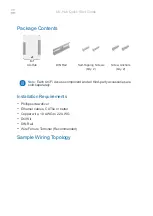
The * or # key can be used more than once to adjust the output as desired (202***, for example). After the
command has been issued, you can enter additional commands for the same channel by simply keying an
additional * or # as needed. You can also use this method to toggle between the A and B state without
reentering the channel number.
Note: Command durations are specified when you set up your Command channels during I/O unit configuration (see
page 39).
Cancelling Commands
Under the Voice Setup tab in the Unit Configuration menu, you can specify a command delay. This is the amount
of time the Voice Interface waits before executing a command issued over the phone. A delay period allows time
to cancel a command or macro entered by mistake.
To cancel all commands awaiting activation, press 0
0#
#. You can then enter new commands or other Voice
Interface codes.
Macro List
To list all of the macros stored on the I/O unit you are connected to, enter 5
5#
#. The Voice Interface will read the
macro number and the corresponding title for each macro saved to the unit.
Running Macros
To run a macro, enter 5
5 __ __ #
#. Fill in the blanks with the appropriate two-digit macro number. The Voice
Interface will then execute the macro. Valid entries are 501-532.
Cancelling Macros
Macros respond to the command delay setting in the same way as commands (see CANCELING COMMANDS,
above). A macro may be canceled by pressing 0
0#
# prior to the expiration of the command delay. Note that this
will not stop a macro that is already running. If a macro is not canceled within the command delay period, it will
continue to run until it reaches its programmed ending point or it is stopped from the Macro Status window in
Lynx (see page 30).
Taking Captures
The Voice Interface can instruct the I/O unit to take a data capture, which later can be downloaded to Lynx and
used for logging and reports.
To take a data capture on the I/O unit you are connected to, enter 0
04
40
0**. The Voice Interface confirms the
capture by saying, “Unit information captured.” To capture data from another I/O unit, you have to first switch
to that unit (see SELECTING AN I/O UNIT, earlier in this chapter).
AUDIO & MICROPHONE FUNCTIONS
Using the Audio Out Connector
The rear panel Audio Out connector (1/8”, mono audio) sends audio from the telephone line to a connected
device. This function can be used to broadcast audio directly from the telephone.
To turn the Audio Out function on, enter 0
08
80
0#
#. The Voice Interface responds, “External audio output On.”
Audio Out is active for the period specified in the Audio Input Timeout field, under the Voice Setup tab in Unit
Configuration (see page 47). To stop Audio Out prior to the timeout, enter 0
08
80
0**.
CHAPTER 11: VOICE INTERFACE OPERATION
117
CUSTOMER SUPPORT: 978-486-3711 • [email protected] • www.burk.com
Summary of Contents for GSC3000
Page 8: ...GSC3000 VRC2500 INSTALLATION OPERATION MANUAL viii ...
Page 22: ...GSC3000 VRC2500 INSTALLATION OPERATION MANUAL 14 ...
Page 32: ...GSC3000 VRC2500 INSTALLATION OPERATION MANUAL 24 ...
Page 40: ...GSC3000 VRC2500 INSTALLATION OPERATION MANUAL 32 ...
Page 52: ...GSC3000 VRC2500 INSTALLATION OPERATION MANUAL 44 ...
Page 68: ...GSC3000 VRC2500 INSTALLATION OPERATION MANUAL 60 ...
Page 120: ...GSC3000 VRC2500 INSTALLATION OPERATION MANUAL 112 ...
Page 128: ...GSC3000 VRC2500 INSTALLATION OPERATION MANUAL 120 ...
Page 132: ...GSC3000 VRC2500 INSTALLATION OPERATION MANUAL 124 ...
Page 140: ...GSC3000 VRC2500 INSTALLATION OPERATION MANUAL 132 ...
Page 144: ...GSC3000 VRC2500 INSTALLATION OPERATION MANUAL 136 ...
















































